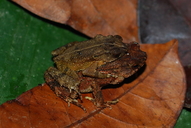|
Ingerophrynus divergens (Peters, 1871)
Crested Toad | family: Bufonidae genus: Ingerophrynus |
 © 2010 Amir Hamidy (1 of 6)
|
|
|
|
Description Dorsal and lateral coloration is generally clay brown but can range from reddish brown (Inger & Stuebing 1997) to blackish brown (Inger 1966). Ventral coloration is yellow or pale brown and may be immaculate or have dark mottling on the throat and chest (Inger 1966). There may be several isolated black spots or inverted black chevrons on the back; a dark interorbital bar is also usually present (Inger 1966). This is distinctive from B. quadriporcatus, which has no black dorsal markings (Inger 1966). A thin, light vertebral line may be present or absent (Inger 1966). Limbs have dark crossbars (Malkmus et al. 2002). There is no documentation of sexual dimorphism in coloration or patterning, nor of metachrosis. Tadpoles are 12.4 mm in Stage III (stage 28, Limbaugh and Volpe, 1957; Inger 1966), 15-17 mm in final stages (Inger and Stuebing 1997). The body is oval-shaped and small, and slightly flattened below (Inger 1966). The tail is lanceolate with a rounded tip; the dorsal fin is slightly deeper than the ventral one, and both fins are deeper than the caudal muscle in the distal half of the tail (Inger 1966). The dorsal fin begins over the posterior quarter of body (Inger 1966). Eyes and nostrils are dorsal; the nostrils are much closer to eyes than to the tip of the snout (Inger 1966). The oral disc is ventral and subterminal, about 1/3 maximum body width (Inger 1966). The spiracle is sinistral, just below the line connecting the center of the eye and the root of the hind limb, and is closer to the hind limb than to the eye (Inger 1966). Papillae are short, in a single row confined to the corners of the mouth (Inger 1966); labial teeth rows formula is 2/3 (Malkmus et al. 2002). 28 teeth counted; rows of upper lip are equal and longer than rows of lower lip, which are subequal; beaks are smooth and narrowly edged with black (Inger 1966). Bufo divergens tadpoles do not have expanded lips like tadpoles of B. asper and B. juxtasper (Inger and Stuebing 1997). Dorsal tadpole coloration is dark gray or brown (Inger 1966) to black (Malkmus et al. 2002), whitish or unpigmented ventrally (Malkmus et al. 2002). The caudal muscle is gray and lighter below; the dorsal fin is also gray, but with dense melanophores; the ventral fin is gray with only a band of melanophores along its base (Inger 1966). Distribution and Habitat Country distribution from AmphibiaWeb's database: Indonesia, Malaysia Malaysian region distribution from AmphibiaWeb's database: Sabah, Sarawak
Life History, Abundance, Activity, and Special Behaviors Females with enlarged pigmented ova were caught in May, June, and July (Inger 1966). Females lay egg strings with numerous, pigmented ova in stagnant or slowly flowing water. Larvae are of a generalized type, with spheroidal bodies, keratinized beaks, and deep fins (Malkmus et al. 2002). Tadpoles occur in the shallow areas of stagnant or slowly flowing water in small streams (Malkmus et al. 2002). Usually tadpoles from eggs laid in small streams are found where the current is weakest (Inger and Stuebing 1997). The tadpoles are bottom suspension feeders (Malkmus et al. 2002). Adults feed on a wide variety of arthropods, favoring ants and termites (Malkmus et al. 2002). This species appears to occur everywhere in well-drained lowland rainforest, but is not considered to be an abundant species (IUCN 2006). Trends and Threats Possible reasons for amphibian decline General habitat alteration and loss Comments
References
Frost, D. R., Grant, T., Faivovich, J., Bain, R. H., Haas, A., Haddad, C. F. B., de Sá, R. O., Channing, A., Wilkinson, M., Donnellan, S. C., Raxworthy, C. J., Campbell, J. A., Blotto, B. L., Moler, P., Drewes, R. C., Nussbaum, R. A., Lynch, J. D., Green D. M., Wheeler, W. C. (2006). "The amphibian tree of life." Bulletin of the American Museum of Natural History, 297, 1-370. [link] IUCN, Conservation International, and NatureServe. 2006. Global Amphibian Assessment: Bufo divergens. www.globalamphibians.org. Accessed on 14 May 2008. Inger, R. F. (1966). ''The systematics and zoogeography of the Amphibia of Borneo.'' Fieldiana Zoology, 52, 1-402. Inger, R. F., and Stuebing, R. B. (1997). A Field Guide to the Frogs of Borneo. Natural History Publications (Borneo) Limited, Kota Kinabalu. Malkmus, R., Manthey, U., Vogel, G., Hoffmann, P., and Kosuch, J. (2002). Amphibians and Reptiles of Mount Kinabalu (North Borneo). Koeltz Scientific Books, Koenigstein, Germany. Voris, H. K. and Inger, R. F. (1995). ''Frog abundance along streams in Bornean forests.'' Conservation Biology, 9(3), 679-683. Originally submitted by: Cindy Liu (first posted 2008-05-07) Edited by: Kellie Whittaker (2014-10-29) Species Account Citation: AmphibiaWeb 2014 Ingerophrynus divergens: Crested Toad <https://amphibiaweb.org/species/6003> University of California, Berkeley, CA, USA. Accessed May 22, 2025.
Feedback or comments about this page.
Citation: AmphibiaWeb. 2025. <https://amphibiaweb.org> University of California, Berkeley, CA, USA. Accessed 22 May 2025. AmphibiaWeb's policy on data use. |





 Map of Life
Map of Life